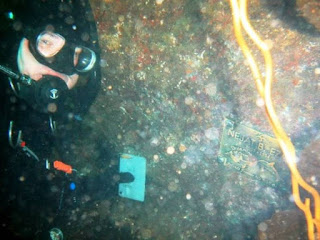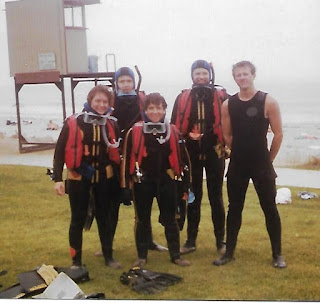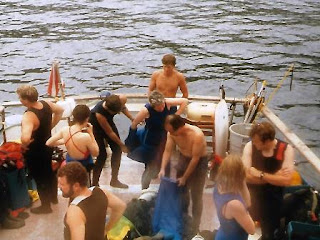A memorial plaque mounted on a huge boulder lies in the shade of the kelp beds of the Casino Point Dive Park, Avalon, Catalina Island.
NEJAT B. EZAL, 1969 – 1994. Dreaming of Orcas. Friends Forever We Will Be
Nejat was my friend. Today marks the 40th anniversary of the accident that claimed his life.
A diver sharing a report of his dives on Scubaboard in
August 2010 remarked “visited the Sue jac (an old wreck that marks one corner
of the park)…the Cousteau memorial. I came across a small memorial plaque to
"Nejat B Ezal" mounted to a rock in the vicinity of the Sue jac but
shallower. Can anyone share the history of this? I didn't see anything about it
elsewhere.”
One reply simply stated “Nejat B Ezal suffered a shallow
water blackout while freediving in 1994 and died. He had just turned 25.” Another referred him to the memorial page at
nejatezal.com.
Many years ago...I met Nejat through his brother, Kenan. We all worked at Delco Systems Operations in Goleta, California, but it was outside of work that I got to know them. In 1984, I got certified as a Basic Scuba Diver in a class at UC Santa Barbara and quickly became obsessed with all things diving. I would swim with fins along the swim buoy line at Goleta Beach to stay in condition for diving. I encountered Nejat and Kenan launching their sailboard from the beach one afternoon. Prior to learning to dive, I too had done a fair amount of sailboarding on my Windsurfer Sport. We struck up a conversation and quickly bonded over our love of the sea.
The brothers also did scuba diving. Nejat advanced to become a divemaster through
a course taught at Santa Barbara Aquatics.
I recall advising him that despite the real frustration he might
experience during the course, there was no better instructor for potential
divemasters than Curt, the owner of the shop.
In 1987, I started a Ph.D. in Political Science at the
University of California, Santa Barbara. The degree provided the vehicle for me to change fields from Aeronautics to Ocean and Coastal Management. A few years later, Nejat asked me about my experience using graduate work as a means of changing fields. He
wanted to move from engineering to marine biology. He easily made the transition.
I would see Nejat around campus and when I was jogging along
the dirt trails of Ellwood Mesa. He
would fall in with me allowing me to set the pace. He was much faster than I.
At UCSB, Nejat quickly built a reputation among the
professors and researchers as a friendly, highly competent, and resourceful
graduate assistant. I recall one story
when Nejat was on a research cruise to the Antarctic to study krill when the
expedition scientists discovered a shortage of test tube stoppers. Using the machine tools onboard the vessel
and rubber bar stock, Nejat produced the needed stoppers.
He continued to dive as a UCSB scientific diver through the
Marine Science Institute and as a member of the UCSB dive club. The latter included camping/dive trips to
Point Lobos State Park, Anacapa Island and the annual dive weekend at Avalon,
Catalina Island.
I recall, in particular, a series of four dives that Nejat
made over the 4th of July weekend in 1992. On Friday, July 3, I was working on my
dissertation with the radio tuned to a local station. The station featured an on air marketplace. I heard the announcer offer two spots on a
Sunday dive boat out of Ventura at half off the regular price. I immediately called the dive shop and
reserved the spots. I called Nejat to
ask if he wanted to go. Luckily, I got
ahold of him. Of course, he said “yes.”
I picked up Nejat at his nearby apartment early Sunday
morning and we headed for Ventura to board Spectre. We settled in, rigged our gear, and after a quick trip across
the Santa Barbara Channel arrived at Anacapa Island. Conditions for diving were ideal, calm seas,
partly sunny skies, and great underwater visibility. We did four dives that day at three different
locations to typical depths for kelp forest dives: 60 feet for 37 minutes; 40 feet for 45 minutes, 50 feet for 40
minutes; and 50 feet for 40 minutes.
Normally, I would only have done three dives. To do four dives on Spectre a diver had to
rush given the tight schedule for opening and closing the gate. I usually enjoyed a more leisurely pace. However, given Nejat’s enthusiasm, I
did make all four. When Nejat told
others at Santa Barbara Aquatics, their incredulous response was “Jim did four
dives?!?”
The Day 30 years ago...The UCSB Scuba Club has made an annual end of April
pilgrimage organized by Ed Stetson to dive the waters off Casino Point since
1979. I first attended the Catalina
Island trip in 1986, then in its 7th year.
I continued to make the trip annually as one of the divemasters until
1993 and have made the event sporadically since 1998. I did not make the trip in 1994. My position as a lecturer teaching a course in
Public Administration during the UCSB spring quarter prevented me from going
that fateful year.
Sunday morning, April 24, found me home at the kitchen table
grading a stack of term papers when the phone rang. I still remember Nejat’s girlfriend, Claire, tearfully
informing me that the day before Nejat had drown while freediving. I was stunned and shocked with a dose of disbelief. After the call, I drove to the nearby Santa
Barbara Aquatics dive shop to see if anyone had further details. From what they gleaned, Nejat had made
multiple solo free dives in the vicinity of the Suejac, probably succumbed to
shallow water blackout and drown.
Everyone was in a state of shocked disbelief.
The following Saturday, family and friends gathered at the
Cliff House overlooking the Pacific at
Coal Oil Point for a celebration of Nejat’s life. During a poignant slide-show narrated by
Nejat’s dad, I was overcome with a profound sense of grief. While I was there to help comfort the family,
they ended up consoling me.
Within a few months, people endowed a number of
scholarships in Nejat’s memory. One of
the scholarships supports Marine Diving Technology students at Santa Barbara
City College. Nejat’s friends organized a Dive Rescue Workshop in the following years that trained divers in
rudimentary dive rescue techniques with the goal of reducing tragedies like the
one that took Nejat.
A short time later… How
the metal plaque came to be placed at the site is something of an local legend. It seems that Avalon had a
policy against installing such monuments.
Shortly before I left Goleta to take up a faculty position at Troy
University in Alabama, Kenan, queried me about how such a plaque could be
affixed to an underwater rock. I
suggested that a waterproof epoxy adhesive much like one used to repair a
swimming pool might work but I was not certain. As I heard the story sometime after. It seems a number of Nejat’s friends, many who
went through the Santa Barbara City College Marine Technology program,
clandestinely installed the plaque during a couple of night dives. The marker is not only secured using
adhesives. They drilled into the rock and secured the memorial with fasteners. The plaque is permanently affixed to the
rock!
More years later…Since moving to Alaska in 2002, my trips to Catalina with the UCSB Scuba Club have been fewer and fewer—2004, 2014, 2022, and 2023. On some of the trips I locate the memorial on others I search but don’t find it. The lineups to geographic references are meticulously recorded in a travel journal that disappeared from my bookshelf. I knowthe plaque is there, other divers reported seeing it in 2022 and 2023. The plaque stands as a testament to a man who loved the sea and the wonders he found in the deep.
Nejat's memorial page can be found at www.nejatezal,com



















